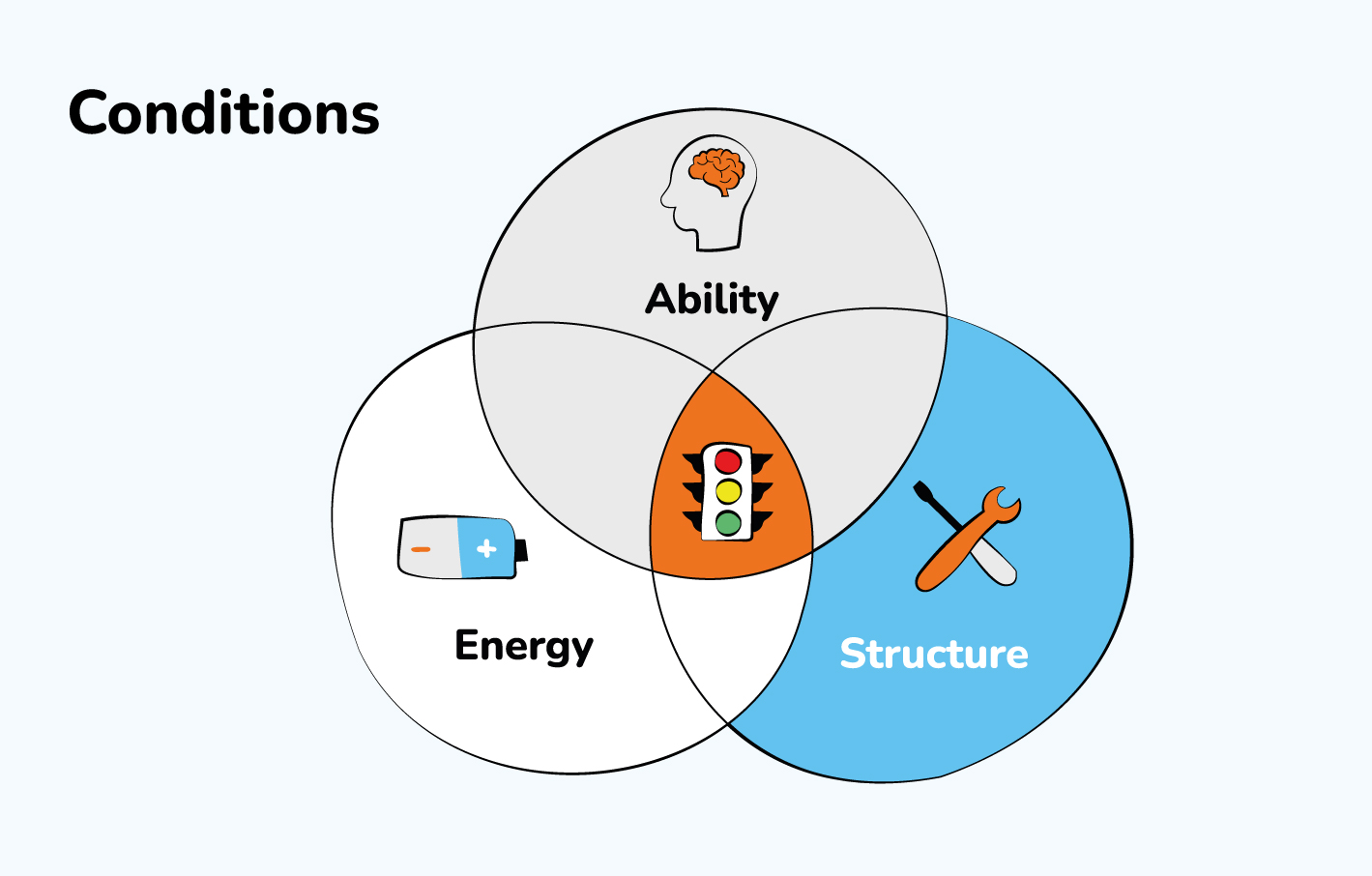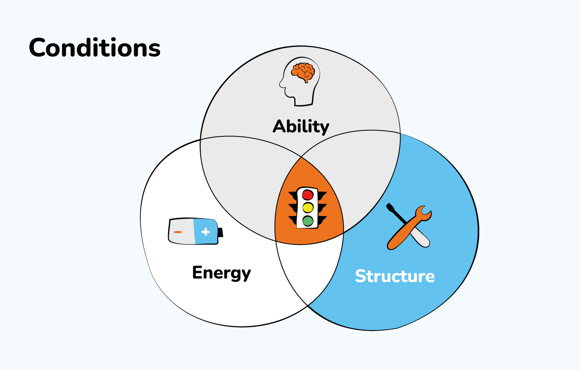About conditions in GoalEnvision

When you have set your goals, it is time to take action. Plans must be made, who will do what and when? But wait a bit, it's easy to go wrong and the goals become just a wishful dream that doesn't really "take" everyday life. Those of you who have been there know what I mean. Setting goals is inspiring, trying to rally everyone around them and actually achieving them is difficult to say the least.
The conditions many miss when they set goals!
3 answers to common questions
- What pitfalls can we avoid when setting goals?
- Why don't we get the organization with us towards the goals?
- Why do our goals just become a boring debriefing at the management meeting?
3 things you might not have known
- Differentiate between the need for structure, abilities and energy to succeed in your goals
- Create conditions for employees to motivate themselves
- Succeed in setting credible goals that you achieve together
When you have set your goals, it is time to take action. Plans must be made, who will do what and when? But wait a bit, it's easy to go wrong and the goals become just a wishful dream that doesn't really "take" everyday life. Those of you who have been there know what I mean. Setting goals is inspiring, trying to rally everyone around them and actually achieving them is, um, tricky.
After leading several companies and participating in over 150 different companies and their journey towards growth, strategy development and goal management, I have seen some typical pitfalls that everyone should be able to avoid. In this article I develop the reasoning around two very important factors for success; employees' motivation and the importance of differentiating conditions and abilities when we set goals
Why don't we get the organization with us towards the goals?
Two common reasons why goals do not lead to action are that they are either too long-term or too short-term. Too long-term goals that are not broken down into more short-term ones become impossible as guidance in daily work. Short-term goals alone do not explain where we want to go with the business in the longer term, and they therefore often feel like the goals are set "right out of the air" without any vision or long-term direction. That doesn't directly benefit motivation, does it?
If you have too long-term goals, there is a risk that they will be completely forgotten, because everyday life knocks on all the time and there is never time for strategy and vision work. For short-term goals, they easily become just a reporting point at the management meeting because they lack a longer direction. A management team I coached was asked; "-Why do you follow this key figure?" and the answer was "-Because it says so on the agenda!". Short-term goals must therefore always be anchored in longer-term strategies in order to be understood and acted upon.
If the employees feel they have insufficient conditions to reach set goals, it can create resistance and impair performance instead of motivating. It is not uncommon to set new challenging goals without determining whether the change is necessary or adds something that provides the support and resources needed. Clarity and consensus are important. If the person who is to achieve the goal does not have control over their situation, the risk of negative stress and stress increases. It rarely leads to any performance improvements or higher motivation.
Break down the goals into conditions
An important ingredient to be able to achieve the goals is therefore to break them down. In GoalEnvision, we break down long-term goals by providing them with the conditions required to achieve the goals. A condition can be perceived as a goal itself, but it is more concrete and must be established, maintained, nurtured and developed. We give the conditions so-called traffic lights to describe their current status. We will return to the traffic lights a little later in the article.
What the conditions are for achieving a certain goal need to be described by those who are affected by the goal. Let me give an example:
At a company a few years ago, the management had a brilliant idea: "-We will increase sales to our major customers". The goal was that sales would be twice as large as today within 2 years.
The sales and marketing team came together to discuss what would make this possible.
"-We need a completely different level of support for them to dare to place more orders with us"
"-Our account managers and project managers must work more proactively and earlier propose solutions for the major customers, and are also encouraged to do so"
"-Our agreement with the big customers should encourage them to place more business with us rather than, as today, forcing them to place a minimum number of orders with us in order not to lose the contract.were
put on the table, which together would constitute the conditions for success. And with the capabilities and competencies that existed in house, the team got a convincing feeling that the goal would be achieved. At each monthly team meeting, it was discussed which conditions were red, yellow or green with high energy.
It was easy to see how each of these conditions could be established. The customer managers received support and training in anticipating the needs of major customers earlier and therefore being able to propose solutions earlier. The agreement was renegotiated to give the big customers a higher price for support cases, they got their own cream pie. And so on. By identifying which conditions were required for the work towards the goal, credibility is created for those responsible to actually be able, willing and achieve the goal.
How GoalEnvision helps you find the conditions
In GoalEnvision, we start from your growth goals and help you break them down and identify which conditions are required to succeed. Because the entire business is connected and must function as a harmonious unit, you get a complete strategic goal picture where everyone is involved and feels motivated to achieve the growth goals. In GoalEnvision, we describe the goal image from five success perspectives, all of which touch on the parts of the organization where the goal belongs. It creates focus, motivation, inspiration and a will for everyone to participate and contribute. In short; it creates energy.
Energy is one of the three factors that are needed for goals to be achieved. We have already given examples of the first factor; conditions. The second factor is ability, i.e. ability or competence to carry out the assignment or work. And finally; energy. Energy is the drive, the will, the motivation and the inspiration.
In each of these areas, we then set measurable goals. In the process of setting our goals, we look back to see what kind of forward-looking data we have and what ambition we have in the short term to ensure our long-term development and ultimately reach to our growth targets.
Up to this point, GoalEnvision is a quick and efficient method of identifying and setting our goals. But, now GoalEnvision is different from other previous methods. With GoalEnvision's method, we do not stop at establishing a certain target value, we go much, much further than that.
Why it works!
When we set goals, we express a desire for a better position in a certain area. We allow ourselves to believe that we can be better. It is a positive exercise where we see ahead of ourselves how we can become better in an area.
There is much to be said about how we set goals, but that is another article. Here I want to talk about the importance of identifying what is needed so that the goal can also be achieved. Before we draw up action plans and dive into the details of who will do what. The concepts of conditions and abilities are important to understand in order to make the right things happen. Two concepts that significantly simplify, unify and create credibility in achieving the goal.

3 types of conditions
conditions are structural, i.e. we build them and then we want them to remain. We develop them, change them, and after a while they may become obsolete. conditions are not tasks that we do and then put behind us. Conditions are met and maintained in turn.
Examples of conditions could be that we have access to the right equipment, that we have smart processes that everyone can follow, that we have access to the right data for our decisions, etc. Such that we assume that employees must take for granted that it exists in order for them to be able to work towards the goal. To further define what conditions are, let's talk a little about what they are NOT. Read more about abilities and energy, the two other factors that are needed to make the right things happen.
Condition 1: Structure
Order and order, knowing what is expected and having the right equipment, materials or other support are all examples of structure. A wise friend of mine once said:
-"Life is probably so complex, let's try to create predictability and stability in what can actually be created stability in. If we can do that, we can handle all the surprises much better, both good and bad.”
Think to yourself; How easy is it to take the car to the customer if the car is missing? You have a driver's license, a map and you're alert and alert, but without a car you can't do it. The car is a structural condition for success. Naive example perhaps, but translate it into the everyday working day of the employees; how easy is it to achieve any goals if the structure is not there?
Here are examples of structural conditions for you to achieve the goals:
- Processes
- Routines
- Equipment
- Materials
- Economy
- System
- Support
- Collaboration
Condition 2: Ability
is something that we humans have, they develop over time and they are preferably transferred to later generations of employees so that the knowledge remains and increases in business. Knowledge and experience in the field required to achieve the goal are conditions for success.
Here are examples of abilities that can be conditions for reaching the goals:
- Knowledge
- Competence
- Experience
- Learning
- Ability
- Talent
- Skill
Condition 3: Energy
Energy is a collective term that includes the factors will, drive, motivation and inspiration. If you have the structure in place, the right ability but lack the energy, it will still be difficult. It can range from simply not wanting to, to not seeing how the tasks bring you any joy or benefit. For a leader, it is therefore of the utmost importance to create an environment where there are opportunities for the organization to find its own motivation, inspiration, will and drive.
Here are some examples of conditions in energy:
- Interest
- Commitment
- Motivation
- Drive
- Lust
- Joy
- Work
Now let's get specific. Below, I describe the work of developing conditions and worked with them in a little more detail.
Describe the goal and its conditions
conditions give the goal a complete picture of the future desired situation, a target picture. Without describing what is required to achieve the goal, the goal is not complete. conditions make the goal complete because it describes what needs to be done in order for us to reach the goal.
Create conditions for the team to motivate itself
Everyone who is affected by a certain goal needs to participate in the discussion about what conditions are required for the goal. Why? Well, because that's how we make sure we let everyone tell us what they think they need to achieve the goal. It benefits everyone's inner motivation. Being able to take part and plan on your own what is needed to reach the goal is hard to beat as a motivating factor. The desire to participate and contribute to the common success is based on the team itself developing its own plan.
Now it may be that everyone affected by the goal cannot gather in one room to discuss together. A tip is then to ask the question: "What are the 3 most important conditions you need to be able to reach the goal?" and collate everyone's responses into a net list of conditions that can then be validated.
The traffic lights
When the list of conditions is complete and everyone has agreed on it, it is time to agree on the current status of each condition. Here we use an estimation model that we call "Traffic lights". A traffic light consists, as you know, of three colors; red, yellow and green.
- A condition where the traffic light is red means that we completely lack this condition.
- A yellow condition means that we only have the condition in place to a certain extent.
- A green condition means that this particular condition is fully sufficient to achieve its part of the goal. (It does not have to mean that it is optimal, conditions develop and improve over time. But green means good enough.)
Do this!
Ask these 3 questions to those directly responsible for achieving the goal:
- What conditions do we already have that we must maintain?
- What conditions do we have to some extent, and do they need to be developed?
- What conditions, which are required to reach the goal, do we lack?
Compile all answers and merge the duplicates. Give the answers to question 1 green, question 2 yellow and question 3 red traffic light.
The action plan
It is much easier to create action plans that describe how each of these red and yellow conditions can be created and developed than trying to see what should be done first if the target picture is not complete.
If you read the article that describes the strategic, tactical and operational perspective in a business, you may also realize that the goals we defined are strategic, the conditions to be achieved are at the tactical level and the action plan creates the operational plan. Now it all comes together.
Experience the magic of doing it together!
Now that everyone has been involved in the work of providing the goal with conditions and abilities, it becomes credible how it is to be achieved. The feeling of togetherness, credibility and the desire to make an effort to achieve the goal is there and that power is enormous.
Good luck!

Jörgen Forslund has 20 years of experience in business management. As CEO, sales manager, marketing manager and also editor-in-chief, he has developed a methodology for leading companies in change processes. As a consultant, Jörgen has many years of experience in entrepreneurship. He provides management support and strategic advice. He supports management in both large and small organizations to succeed with their business development.
Share this article
Did you like this article? Here is more...
Are there any disadvantages or potential dangers when working with goals? What can the risks be for anything? What happens if you set too long-term goals? Here, questions about pitfalls in goal work are answered.